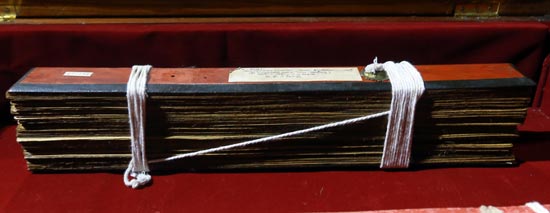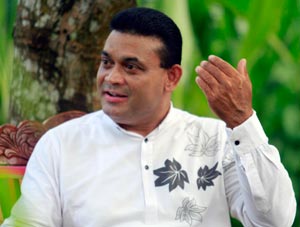In search of the perfect Mahavamsa
This is the version of the Mahavamsa; the chronicle our island nation’s saga that has gone into the annals of the UNESCO list of items of documentary heritage. It was in July that the UNESCO (United Nations Educational Scientific and Cultural Organization) named the Mahavamsa among the 64 new items of documentary heritage inscribed on the UNESCO’s Memory of the World (MoW) International Register in 2023.

A national treasure: The unique ola manuscript. Pix by Indika Handuwala
The UNESCO said the Mahavamsa was the first of its kind in South Asia, initiating a mature historiographical tradition, presenting Sri Lanka’s history in a chronological order from the 6th century BCE and that the authenticity of the facts provided in the document has been confirmed through archaeological research conducted in Sri Lanka and India.
“It is an important historical source in South Asia containing crucial information about the lifetime of the Buddha, the Emperor Asoka and the rise of Buddhism as a world religion,” the UNESCO press release said.
“The document played a significant role in popularising Buddhism in Southeast Asia and contributed singularly to the identity of Emperor Asoka in Indian history.
“The existence of a number of manuscripts of the Mahavamsa in several countries as well as the transliteration and translation of the text to several Southeast Asian and European languages stand testimony to its immense historical, cultural, literal, linguistic and scholarly values,” the UNESCO said.

Prof. Rohitha Dasanayaka
Though now out of bounds to the reader in the campus library, this manuscript which can be traced back to the early 19th Century and the burgeoning British rule in the country, is handsome to look at even after more than two centuries, with the flaming cinnamon orange of a monk’s robe and elegant lettering on the kambawa (cover).
The journey to venerability for this copy began a few years back when a team of historians headed by Prof Malani Endagama, initiated a hunt for the ‘perfectest possible’ copy of the Mahavamsa to be scrutinised by the UNESCO.
Many were the contenders. Temples around the country yielded copies – crumbling to well-preserved. There was one from the Ridi Vihara that almost made the cut, but four other copies were finalised.
There was one from the Kandy Maligawa and three from the library of the University of Peradeniya.
The challenging task of choosing the best out of the three ‘Pera’ copies, fell on the shoulders of three academics of the University’s History Department: Head of Department Prof. K.M. Rohitha Dasanayaka, Senior Professor Mahinda Somathilake and U.S.Y. Sahan Mahesh
Says Prof. Rohitha, “We pored over the copies together, and it became clear that one copy stood out. While the other two had numerous inconsistencies this one was beautiful and neat.”
Written in a beautiful curvy hand the manuscript probably belongs to that cusp when the Kandyan kingdom fell to the hands of the British.
The Mahavamsa has recorded the ebb and flow of our fortunes from the mythical times of Vijaya – the Indian prince to the end of the civil war in 2009. The first section comes to a halt with the end of King Mahasen (whose reign ends in 304 CE) and was written by the monk Mahanama.
The second part carries on the odyssey till 1815, which is when this particular version ends.
It is said this was compiled by the Ven. Thibbotuwawe Buddharakkhita Thera but as he had died by 1815, Prof. Rohitha assumes the final part was inscribed by an acolyte – who ‘did a very neat job’ by seamlessly adding his bit.
Prof. Rohitha meanwhile wants to dismantle the myth that the Mahavamsa is a history of the Sinhalese people alone.
“In fact, Elara (the South Indian invader) was the most vaunted and most revered monarch in the Mahavamsa. It was the tradition in the chronicle that ensured every passerby had to respect the tomb of the Tamilian king as decreed by Dutugemunu – observed by the Adigar Pilimatalawwe even when fleeing – as late as the 19th Century.”
Also, although written by the monks of the Maha Vihara (the old conventional Theravada tradition, whose rivals were the Abhayagiri monastery), the chronicle is not all religious either.
Moreover it sheds so much light on the dim stage of Indian history where no proper counterparts of our vamsakatha survive.
According to Prof. Rohitha however, the Mahavamsa became a part of global heritage many centuries ago. As, in the time of the elder Parakramabahu, it was taken to Cambodia and rendered into that tongue.
Meanwhile Prof. Rohitha with others in the fraternity of antiquarians are alert to the reports that a copy of the ‘polar’ version of the Mahavamsa has surfaced in Germany (whither went a lot of our old documents) – written by the rivals of the Maha Vihara chroniclers – the monks of Abhayagiri.
He keeps his fingers crossed. “If we find it,
Sri Lankan history as we know it will be completely transformed,” he says with anticipation.
Searching for an ideal partner? Find your soul mate on Hitad.lk, Sri Lanka's favourite marriage proposals page. With Hitad.lk matrimonial advertisements you have access to thousands of ads from potential suitors who are looking for someone just like you.


